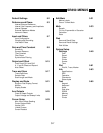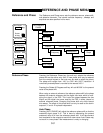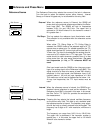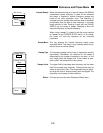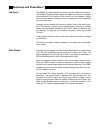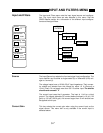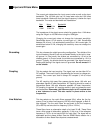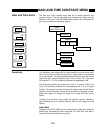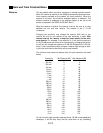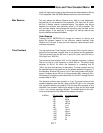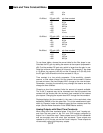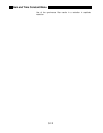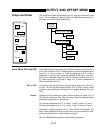
5-8
Input and Filters Menu
The current gain determines the input current noise as well as the input
bandwidth. The 100 MΩ gain has 10 times lower noise but 100 times
lower bandwidth. Make sure that the signal frequency is below the input
bandwidth. The noise and bandwidth are listed below.
Gain Noise Bandwidth
1M 130 fA/√Hz 70 kHz
100M 13 fA/√Hz 700 Hz
The impedance of the signal source should be greater than 1 MΩ when
using the 1M gain or 100 MΩ when using the 100M gain.
Changing the current gain does not change the instrument sensitivity.
Sensitivities above 10 nA require a current gain of 1 MΩ. Sensitivities
between 20 nA and 1 µA automatically select the 1 MΩ current gain. At
sensitivities below 20 nA, changing the sensitivity does not change the
current gain.
Grounding This key chooses the shield grounding configuration. The shields of the
input connectors (A and B) are not connected directly to the lock-in chas-
sis ground. In Float mode, the shields are connected by 10 kΩ to the
chassis ground. In Ground mode, the shields are connected by 10 Ω to
ground. Typically, the shields should be grounded if the signal source is
floating and floating if the signal source is grounded. Do not exceed 1 V
on the shields.
Coupling This key selects the input coupling. The signal input can be either AC or
DC coupled. The current input is coupled after the current to voltage con-
version. The current input itself is always DC coupled (1 kΩ to virtual
ground).
The AC coupling high pass filter passes signals above 160 mHz and
attenuates signals at lower frequencies. AC coupling should be used at
frequencies above 160 mHz whenever possible. At lower frequencies,
DC coupling is required. AC coupling results in gain and phase errors at
low frequencies. Remember, the Reference Input is AC coupled when
a sine reference is used. This also results in phase errors at low
frequencies.
Line Notches This key selects no line notch filters engaged (Out), either the line fre-
quency (Line) or twice line frequency (2xLine) notch engaged, or Both fil-
ters engaged. The line notch filters are pre-tuned to the line frequency
(50 or 60 Hz) and twice the line frequency (100 or 120 Hz).
These filters have an attenuation depth of at least 30 dB. These filters
have a finite range of attenuation, generally 10 Hz or so. If the reference
frequency is 70 Hz, do not use the 60 Hz notch filter! The signal will be
attenuated and the phase shifted. See the SR850 Basics section for a
discussion of when these filters improve a measurement.




